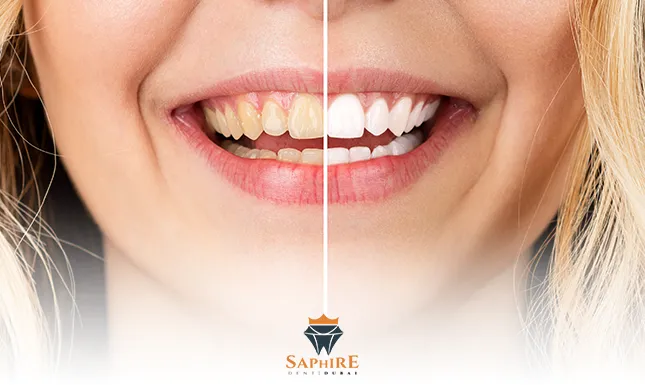What is the difference between dental implants and dental bridges?
Missing teeth are a problem that affects the appearance and function of the mouth. Fortunately, modern dental techniques offer effective solutions for restoring missing teeth, including dental implants and dental bridges. However, you may feel confused when choosing the right solution for you. So let’s go through the differences between dental implants and dental bridges to help you make a decision.
What are dental implants?
A dental implant is a screw that takes the place of a missing root made of titanium or zirconium, which is surgically placed into the jawbone. These roots act as stable supports for custom-made crowns that closely resemble natural teeth.
Components of a dental implant:
Implant body (the screw)
A screw made of titanium or zirconium that integrates with the jawbone
Crown
The artificial tooth placed over the abutment and appears above the gum line.
Abutment
A piece that connects the root to the crowns.

Dental implant procedure
The dental implant process usually consists of two main stages
Surgical phase
The dentist places the root in the jawbone and stitches the area. The jawbone needs several months to integrate around the implant.
Restorative phase
After full integration, the dentist places a healing abutment on the dental implant, shaping the gum around the crown, then taking measurements and fitting the tooth.
Benefits of dental implants:
Aesthetic benefits
Look and function like natural teeth, boosting self-confidence and improving quality of life.
Functional benefits
Allow natural chewing and clear speech.
Long-term oral health
Do not affect adjacent teeth, preserving overall oral health.
Long-lasting durability
Can last many years, even a lifetime in some cases.
Improved jawbone health
Stimulate the jawbone to stay active and prevent its deterioration.
Medical benefits
Preserve natural dental tissues intact.
What are dental bridges?
A dental bridge is a fixed structure used to replace one or more missing teeth. The bridge consists of two or more crowns connected to each other and is attached to the adjacent teeth of the missing tooth.
Types of dental bridges
Tooth-supported bridge
The most common type. It is attached to the natural teeth adjacent to the missing tooth.
Implant-supported bridge
It is attached to dental implants instead of natural teeth.

Dental bridge procedure:
The dental bridge procedure usually consists of two main steps:
1. Preparing the supporting teeth
The adjacent teeth to the missing tooth are prepared (shaped) for the bridge to be attached and may or may not need root canal treatment depending on the condition of the teeth.
2. Placing the bridge
The bridge is attached to the supporting teeth using strong adhesive.
Benefits of dental bridges:
Comparison between dental implants and dental bridges
When to choose dental implants?
1 #
Loss of one or more teeth
Can replace any number of missing teeth.
2 #
Desire for a permanent solution
Looking for a long-term solution to replace missing teeth.
3 #
Good oral health
You have strong jawbones and healthy teeth.
4 #
Don't mind a surgical procedure
Willing to undergo a simple surgery.
5 #
Dental implants allow preserving the adjacent dental tissues around the missing tooth area intact without shaping.
When to choose dental bridges?
1 #
Loss of one or two teeth
Suitable for replacing one or two adjacent teeth or more depending on the number of natural teeth remaining adjacent to the loss.
2 #
Do not prefer a surgical procedure
Prefer to avoid surgery.
3 #
Inadequate jawbone condition for implants
Do not have strong enough jawbones to support implants and do not wish to undergo surgical bone grafting.

Factors to consider when making a decision:
Oral health
Dental implants require strong jawbones. Dental bridges can be a good option if you have strong adjacent teeth to support the bridge.
Number of missing teeth
Dental implants are a better option if you need to replace many scattered teeth or all your teeth in the jaw. Dental bridges are more suitable for replacing one or two adjacent teeth.
Personal preferences
If you are looking for a long-term permanent solution and don’t mind a surgical procedure, dental implants may be the best option for you. If you prefer not to undergo surgery, dental bridges may be the suitable choice.
Caring for dental implants and bridges:
It is important to care for dental implants and bridges the same way you care for your natural teeth. This includes:
Brushing with toothpaste twice daily
Use a soft-bristled toothbrush and fluoride toothpaste.
Using dental floss once daily
To remove plaque and food from between the teeth, bridge, or implant.
Regular dental visits
For routine check-ups and cleanings.
By following these tips, you can ensure your dental implants and bridges continue to function well for many years to come.
Frequently Asked Questions:
The dental implant procedure usually consists of two main stages: the surgical stage and the restorative stage. The surgical stage ranges from fifteen minutes to one hour depending on the number of implants, while the restorative stage takes several months for the root (implant) to integrate with the jawbone.
Local anesthesia is used during the dental implant procedure to minimize any pain or discomfort. You may feel some discomfort after surgery, but it can be relieved with pain relievers.
With proper care, dental implants can last a lifetime. However, some factors and general diseases, such as uncontrolled diabetes and some smoking diseases and poor oral health, can affect their lifespan.
If you are not a candidate for dental implants or bridges, there may be alternative options available, such as partial or complete dentures. Discuss with your dentist the options available to determine the best solution for your oral health.
In conclusion:
Choosing an appropriate solution to replace missing teeth is an important decision that affects your health and quality of life. By understanding the differences between dental implants and dental bridges, and discussing the available options with an experienced dentist, you can make the right decision for your long-term oral health.




